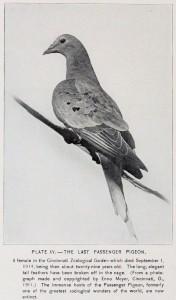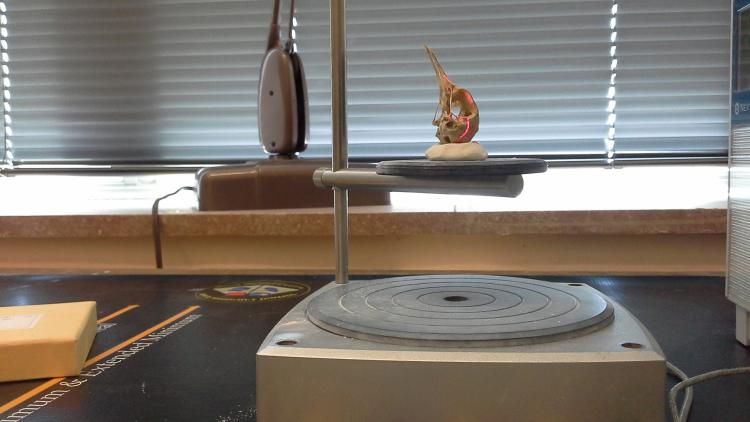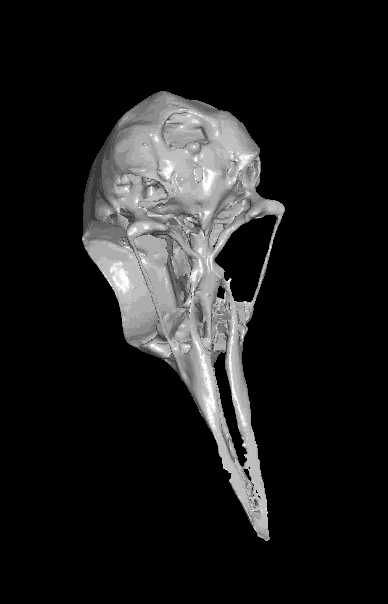 Every school child learns about the extinction of the passenger pigeon. It is one of the great, representative stories of man’s hubris and carelessness. The pigeons once took to the sky in the thousands and then, on September 1, 1914, the last known passenger pigeon died. In just a few hundred years, habitat destruction and sport hunting had driven the animal from the face of the earth.
Every school child learns about the extinction of the passenger pigeon. It is one of the great, representative stories of man’s hubris and carelessness. The pigeons once took to the sky in the thousands and then, on September 1, 1914, the last known passenger pigeon died. In just a few hundred years, habitat destruction and sport hunting had driven the animal from the face of the earth.
The bones belonging to some of those unfortunate birds are now being scanned as part of the Virtual Curation Library (VCL). The VCL began in 2011 as part of a Department of Defense funded project titled “Virtual Artifact Curation: Three-Dimensional Digital Data Collection for Artifact Analysis and Interpretation.” A goal of this undertaking was to investigate the range of the NextEngine Desktop 3D scanner by using it on a wide variety of subject matter.
The post-cranial bones of the Passenger Pigeon came from the collection of the Virginia Museum of Natural History. It was with the guidance of Dr. Elizabeth Moore that these elements were made available for this landmark project. Brian Schmidt, Director of the Division of Birds at the Smithsonian’s National Museum of Natural History was able to provide two skulls for the project. Marianna Zechini, formerly an undergraduate student at Virginia Commonwealth University and currently a graduate student at the University of West Florida, began scanning the bones of passenger pigeons as part of her undergraduate research.
The models that she created could then be shared with researchers around the world. Those researchers are able to closely examine the 3-D models created from every possible angle. This is a dramatic improvement over what was available with just photographs or illustrations. In addition, the existence of these 3-D models allows for accurate measurements by researchers as they compare elements.
Of course, an additional benefit of the existence of these 3-D models is that they can be printed. This allows researchers to have access to specimens they can hold in their hands. It also means that museums and educators can help people make connections with these disappeared animals and help them feel the reality of their absence. The models can be printed on home desktop 3-D printers or commercially produced in plastic, metal, ceramic, and even chocolate.
In 2013, the VCL began a new project called “Virtual Mobility Archaeology Project with Further Applications of Three Dimensional Digital Scanning of Archaeological Objects.” This project will result in the creation of a digital type collection that will help in the accurate indication of materials recovered at archaeological sites.
In addition to the models that were created there is also a Beta version of an app now available to allow anyone to both view and manipulate the scans. The team anticipates additional elements to be added to the models as they edit their scans. The creation of the digital models was particularly challenging because of the thinness and diminutive size of the passenger pigeon’s bones. This would not be a problem with larger skeletons such as those recovered from fossils of dinosaurs. The potential for the collection of scans for extinct creatures is nearly limitless. We can foresee a day in which every museum has a collection of 3D printed artifacts allowing its visitors to physically interact with all that remains of a species.
And, of course, what could possibly be a more romantic gesture than presenting someone with the cranium of an extinct pigeon on Valentine’s Day? Discuss this interesting use of 3D scanning and printing, in the 3D printed passenger pigeon forum thread on 3DPB.com.
Subscribe to Our Email Newsletter
Stay up-to-date on all the latest news from the 3D printing industry and receive information and offers from third party vendors.
You May Also Like
Why Corrosive Resistant Materials Are Important to the Success of 3D Printing Across Industries
The adoption of additive manufacturing (AM) is accelerating across many major industries. As this technological shift unfolds, the importance of corrosion resistance has emerged as a challenge for 3D printing...
America Makes Announces IMPACT 2.0: $6.6M in New 3D Printing Funding
America Makes, the Manufacturing Innovation Institute (MII) based in Youngstown, Ohio, has announced IMPACT (Improvement in Manufacturing Productivity via Additive Capabilities and Techno-Economic Analysis) 2.0, a project call which will...
3D Printing Webinar and Event Roundup: April 14, 2024
We’re starting off the week’s 3D printing webinars and events at ASTM AMCOE’s 11th Snapshot Workshop and MACH Exhibition. Stratasys continues its advanced training courses, SME is holding a virtual...
AMUK Welcomes Airframe Designs as British 3D Printing Industry Grows
While the UK is not the hub for 3D printer and materials manufacturers as other nations, the country continues to excel at the research, development, and application of additive manufacturing...

































